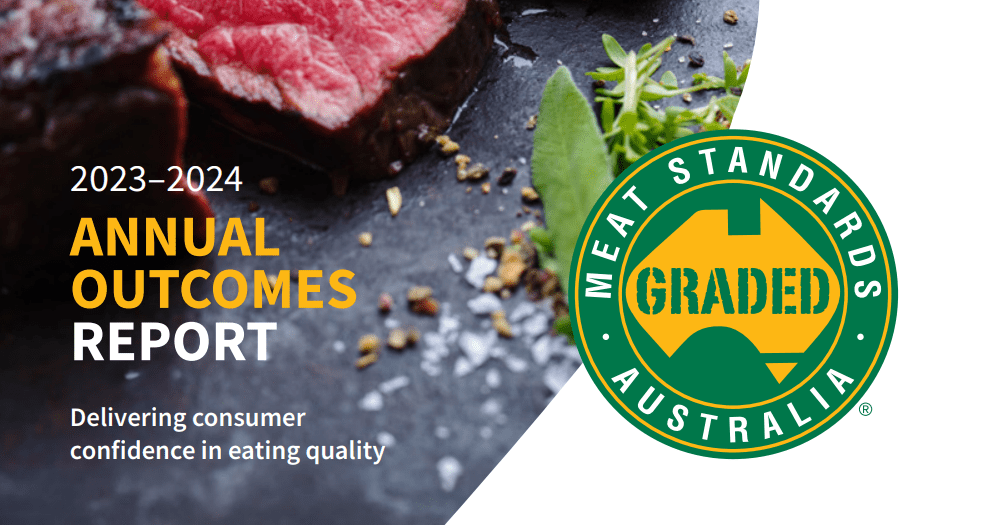
AUSTRALIAN lamb producers are putting more lambs through Meat Standards Australia pathways to boost eating quality for consumers — more than 2.37 million lambs in 2023-24.
However, Australia’s MSA sheep meat system is still in development from its current carcase-based criteria, with objective eating quality assessment and a cuts-based model yet to be fully commercialised.
About 17 years after the introduction of the MSA sheep meat system, MSA-trademarked lambs represent just 10 percent of total lambs slaughtered, although 61pc of lambs processed annually in Australia follow processes that optimise eating quality.
According to Meat & Livestock Australia’s latest MSA Annual Outcomes Report, 99.3pc of the lambs presented through MSA pathways are meeting the program’s minimum requirements that include finished lambs (GR>6mm) with reduced stress within set weight ranges having been on-farm for a certain period, and subject to feed curfew and wool length limits.
Processors have played their part by implementing further MSA requirements such as carcase stimulation and minimum aging requirements. There are now 14 MSA-licensed processing plants that follow processes to improve eating quality — in New South Wales, Victoria, South Australia and Western Australia.
However, unlike for the beef industry and despite some data on retail and wholesale price differentials between MSA and non-MSA lamb, unlike in the beef industry, estimates of the farmgate value of the existing MSA lamb system seem harder to calculate. Meat & Livestock Australia estimated the MSA program delivered a record $326 million in estimated additional farm gate returns to MSA beef producers in 2023-24, up from the previous record of $259 million in 2022-23.
The current MSA sheep meat system is carcase-based and does not apply a grade to the carcase or cuts per se, and lamb grid payments are not yet fully structured to MSA quality grading as in the beef industry.
MSA program manager David Packer said producers providing lambs to MSA-graded and branded supply chain would be getting some benefits versus supplying to non-MSA graded grids, but a certain amount of value would also be attributed to the brand.
“The industry is a whole is getting a benefit.”
Mr Packer said the introduction of electric stimulation in MSA pathways in 2007 helped progress the industry, but calculation of the full value of MSA grading the industry has been waiting on the full development of technology to assess eating quality traits in plants, commercialisation of the cuts-based model and reflection of this in processor grids.
In the outcomes report, MLA said 447 sheep producers and 1440 beef/sheep producers became MSA registered in 2023–24, taking the total number of MSA registered sheep producers to 27,358, representing 35pc of LPA-accredited sheep properties.
Victoria processed the greatest number of lambs through MSA pathways at 1 million head. Western Australia had the greatest increase in lambs through MSA pathways for the second consecutive year with an additional 77,720 head or 15% increase. A total of 99.3% of all lambs presented for MSA met the program’s minimum requirements – an increase of 2.3 percentage points compared to 2022–23.
Dr Packer said the MSA sheep meat cuts-based model continues to move closer to commercialisation with further supply chain activities undertaken in 2023-24 to understand eating quality variation in commercial supply chains and examine brand opportunities.
“A number of processors have now been able to trial higher eating quality lamb in both domestic and international markets.
“Their aim is to understand consumer sentiment and willingness to pay for eating quality consistency, providing opportunity for branding of Australian sheep meat underpinned by eating quality grading,” he said.
Dr Packer said several sheep carcase competitions have now included eating quality through the MSA sheep meat cuts-based model, including the 2024 LambEx carcase competition.
“This allows for participants and observers to understand current eating quality performance in balance with other value drivers such as feedlot performance or carcase weight, providing insights into opportunities for improvements,” Dr Packer said.